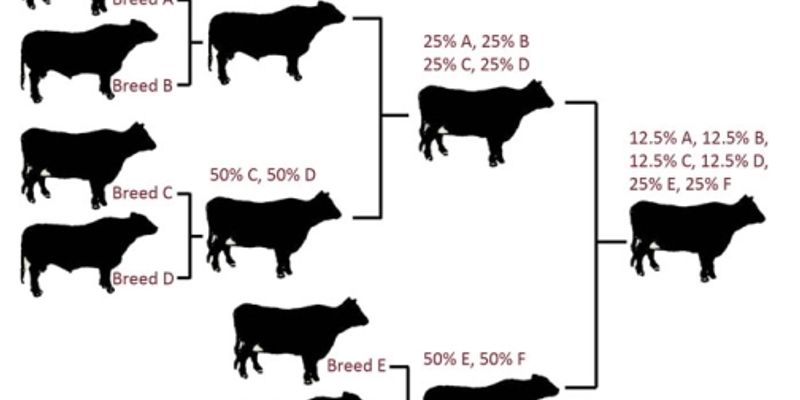Breeding
Breeding: is the mating and production of offspring by animals. To breed is to have babies, whether you're a human or a hermit crab. ... The word breed comes from the Old English bredan which means to "bring young to birth," but also "cherish," which is how most people feel about their offspring.
-
JUL 21, 2017 | 10:00 AMDATE: July 21, 2017TIME: 10:00am PT, 1:00pm ETCRISPR/Cas9 techniques are quickly growing in popularity for the generation of new mouse models for research. Though the approach is relati...MAY 31, 2017 | 9:00 AMDATE: May 31, 2017TIME: 9:00AM PDT, 12:00PM ETAlthough more remains to be learnt, great advances have recently been made in the understanding of the molecular & genetic bases of dis...FEB 09, 2017 | 10:30 AMDATE: February 9, 2017TIME: 10:30am PT, 1:30pm ETDuring the last 50 years the claims for continuous development and training of laboratory animal staff has been progressively devel...Speaker: Axel Kornerup Hansen, DVMPresented at: Laboratory Animal Sciences Virtual Event Series 2017
FEB 08, 2017 | 1:30 PMDATE: February 8, 2017TIME: 1:30pm PT, 4:30pm ETThe powerful and expanding use of genetically modified mice introduces important aspects of genetics in managing these strains for breedi...FEB 08, 2017 | 12:00 PMDATE: February 8, 2017TIME: 12:00pm PT, 3:00pm ETLarge animal models have recently become a staple in biomedical research. The pig’s similarities to humans in terms of genet...FEB 08, 2017 | 10:30 AMDATE: February 8, 2017TIME: 10:30am PT, 1:30pm ETThe cat remains an important comparative species for studying the long-term safety and efficacy of emergent medical modalities, such as...FEB 08, 2017 | 9:00 AMDATE: February 8, 2017TIME: 9:00am PT, 12:00pm ETThere are many factors involved in rabbit breeding that impact performance. In this evaluation of a Dutch Belted rabbit breeding c...MAY 11, 2016 | 1:30 PMThe clinical utility of high-dimensional molecular profiling has been provisionally established in several domains of medicine. Today, interrogation of scores of genes and even whole ex...FEB 04, 2016 | 3:00 PMA crucial part of providing animals for research is successful breeding. Still, in many mouse facilities breeding efficiency is complicated by problems with reproduction, such as pre-weaning...FEB 04, 2016 | 10:30 AMThe environment has been found to be a major contributor to data variability and many aspects of the laboratory environment are stressful to rodents and do not accurately reflect the human ex...FEB 03, 2016 | 12:00 PMThis presentation will discuss variables in rodent colony management that can affect colony breeding efficiency, rodent health, and factors that can modulate rodent models of disease. V...Speaker: Mandy Horn, MS , Sheri Wildt, MS, MBA, CMARPresented at: Laboratory Animal Sciences Virtual Event Series 2016
SEP 30, 2015 | 6:00 AMThe genome determines changes of the transcription profile upon environmental changes and finally determines how a cell reacts. A comparative genome and transcriptome analysis of the same sam...Speaker: Christian Korfhage, PhDFEB 05, 2015 | 3:00 PMC.E. CREDITSAs evidenced by the changes in the new Guide for the Care and Use of Laboratory animals and the latest AVMA Panel on Euthanasia, it is clear that there is growing concern about the care and w...FEB 05, 2015 | 2:00 PMC.E. CREDITSThe ability to breed zebrafish in the laboratory goes a long way in determining the success or failure a research program. The complexity of zebrafish reproductive behavior and spawning i...Speaker: Christian Lawrence, MSPresented at: Laboratory Animal Sciences Virtual Event Series 2015
FEB 06, 2014 | 11:00 AMThe environment in which laboratory rodents are kept has an impact on experimental data and breeding performance. The quality of the environment is defined by both the quality of the primary...FEB 06, 2014 | 9:00 AMC.E. CREDITSAs the prevalence of the use of Zebrafish as an animal model continues its ballistic growth, the need for a better understanding of the factors that add up to success is needed. Topics cover...FEB 06, 2014 | 9:00 AMC.E. CREDITSThe new animal facility is designed to breed and house rodents with the best quality of macro and micro environment and house the maximum possible number of rodents per sf2. This new facilit...Speaker: Jorge Fernandez Hernandez, DVMPresented at: Laboratory Animal Sciences Virtual Event Series 2014
FEB 05, 2014 | 5:00 PMMonitoring the health of laboratory rodents is an important tool for improving the quality of animals used in research. However not all animal facilities have the same requirements, and an ex...Speaker: Jenny Kingham, BVSc, MACVSc ( Lab Anim)Presented at: Laboratory Animal Sciences Virtual Event Series 2014
FEB 05, 2014 | 4:00 PMThe popularity reached by the genetic manipulation of laboratory animals to create new models for studying human diseases, produced in turn, that the techniques for assisted reproduction cons...Speaker: Jorge Sztein, DVM, PhDPresented at: Laboratory Animal Sciences Virtual Event Series 2014
FEB 05, 2014 | 2:00 PMC.E. CREDITSIt is increasingly recognized that the genetic background (i.e., all genomic sequences other than the gene(s) of interest) can have profound influences on the phenotype of an animal model. I...Speaker: Fernando Benavides, DVM, PhD, DACLAMPresented at: Laboratory Animal Sciences Virtual Event Series 2014
FEB 05, 2014 | 1:00 PMTraining for researchers using animals is a requirement in most European countries. However, somewhat surprisingly, the main actor in providing specific guidelines for such training is a scie...
JUL 21, 2017 | 10:00 AM
DATE: July 21, 2017TIME: 10:00am PT, 1:00pm ETCRISPR/Cas9 techniques are quickly growing in popularity for the generation of new mouse models for research. Though the approach is relati...
MAY 31, 2017 | 9:00 AM
DATE: May 31, 2017TIME: 9:00AM PDT, 12:00PM ETAlthough more remains to be learnt, great advances have recently been made in the understanding of the molecular & genetic bases of dis...
FEB 09, 2017 | 10:30 AM
DATE: February 9, 2017TIME: 10:30am PT, 1:30pm ETDuring the last 50 years the claims for continuous development and training of laboratory animal staff has been progressively devel...
Speaker:
Axel Kornerup Hansen, DVM
Presented at: Laboratory Animal Sciences Virtual Event Series 2017
FEB 08, 2017 | 1:30 PM
DATE: February 8, 2017TIME: 1:30pm PT, 4:30pm ETThe powerful and expanding use of genetically modified mice introduces important aspects of genetics in managing these strains for breedi...
FEB 08, 2017 | 12:00 PM
DATE: February 8, 2017TIME: 12:00pm PT, 3:00pm ETLarge animal models have recently become a staple in biomedical research. The pig’s similarities to humans in terms of genet...
FEB 08, 2017 | 10:30 AM
DATE: February 8, 2017TIME: 10:30am PT, 1:30pm ETThe cat remains an important comparative species for studying the long-term safety and efficacy of emergent medical modalities, such as...
FEB 08, 2017 | 9:00 AM
DATE: February 8, 2017TIME: 9:00am PT, 12:00pm ETThere are many factors involved in rabbit breeding that impact performance. In this evaluation of a Dutch Belted rabbit breeding c...
MAY 11, 2016 | 1:30 PM
The clinical utility of high-dimensional molecular profiling has been provisionally established in several domains of medicine. Today, interrogation of scores of genes and even whole ex...
FEB 04, 2016 | 3:00 PM
A crucial part of providing animals for research is successful breeding. Still, in many mouse facilities breeding efficiency is complicated by problems with reproduction, such as pre-weaning...
FEB 04, 2016 | 10:30 AM
The environment has been found to be a major contributor to data variability and many aspects of the laboratory environment are stressful to rodents and do not accurately reflect the human ex...
FEB 03, 2016 | 12:00 PM
This presentation will discuss variables in rodent colony management that can affect colony breeding efficiency, rodent health, and factors that can modulate rodent models of disease. V...
Speaker:
Mandy Horn, MS
, Sheri Wildt, MS, MBA, CMAR
Presented at: Laboratory Animal Sciences Virtual Event Series 2016
SEP 30, 2015 | 6:00 AM
The genome determines changes of the transcription profile upon environmental changes and finally determines how a cell reacts. A comparative genome and transcriptome analysis of the same sam...
Speaker:
Christian Korfhage, PhD
FEB 05, 2015 | 3:00 PM
C.E. CREDITS
As evidenced by the changes in the new Guide for the Care and Use of Laboratory animals and the latest AVMA Panel on Euthanasia, it is clear that there is growing concern about the care and w...
FEB 05, 2015 | 2:00 PM
C.E. CREDITS
The ability to breed zebrafish in the laboratory goes a long way in determining the success or failure a research program. The complexity of zebrafish reproductive behavior and spawning i...
Speaker:
Christian Lawrence, MS
Presented at: Laboratory Animal Sciences Virtual Event Series 2015
FEB 06, 2014 | 11:00 AM
The environment in which laboratory rodents are kept has an impact on experimental data and breeding performance. The quality of the environment is defined by both the quality of the primary...
FEB 06, 2014 | 9:00 AM
C.E. CREDITS
As the prevalence of the use of Zebrafish as an animal model continues its ballistic growth, the need for a better understanding of the factors that add up to success is needed. Topics cover...
FEB 06, 2014 | 9:00 AM
C.E. CREDITS
The new animal facility is designed to breed and house rodents with the best quality of macro and micro environment and house the maximum possible number of rodents per sf2. This new facilit...
Speaker:
Jorge Fernandez Hernandez, DVM
Presented at: Laboratory Animal Sciences Virtual Event Series 2014
FEB 05, 2014 | 5:00 PM
Monitoring the health of laboratory rodents is an important tool for improving the quality of animals used in research. However not all animal facilities have the same requirements, and an ex...
Speaker:
Jenny Kingham, BVSc, MACVSc ( Lab Anim)
Presented at: Laboratory Animal Sciences Virtual Event Series 2014
FEB 05, 2014 | 4:00 PM
The popularity reached by the genetic manipulation of laboratory animals to create new models for studying human diseases, produced in turn, that the techniques for assisted reproduction cons...
Speaker:
Jorge Sztein, DVM, PhD
Presented at: Laboratory Animal Sciences Virtual Event Series 2014
FEB 05, 2014 | 2:00 PM
C.E. CREDITS
It is increasingly recognized that the genetic background (i.e., all genomic sequences other than the gene(s) of interest) can have profound influences on the phenotype of an animal model. I...
Speaker:
Fernando Benavides, DVM, PhD, DACLAM
Presented at: Laboratory Animal Sciences Virtual Event Series 2014
FEB 05, 2014 | 1:00 PM
Training for researchers using animals is a requirement in most European countries. However, somewhat surprisingly, the main actor in providing specific guidelines for such training is a scie...





















